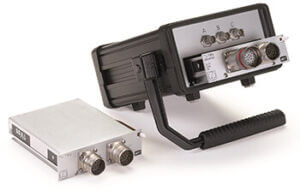September 20, 2015
Diagnostic and testing equipment available
The importance of having the right tool for the job is paramount. That’s why HEIDENHAIN offers tools to check and adjust its incremental and absolute linear and angular encoders. Today, we feature the PWM 20(for encoders with  absolute and incremental interfaces) and the PWM 9 (for incremental linear and angular encoders).
absolute and incremental interfaces) and the PWM 9 (for incremental linear and angular encoders).
PWM 20
The PWM 20 phase angle measuring unit (right) serves together with the provided ATS adjusting and testing software for diagnosis and adjustment of HEIDENHAIN encoders.
PWM 9
The PWM 9 (left) is a universal measuring device for checking and adjusting HEIDENHAIN incremental encoders. Expansion modules are available for checking the various types of encoder signals. The values can be read on an LCD monitor. Soft keys provide ease of operation.
Diagnostic Overview
It is important to note that HEIDENHAIN encoders are already provided with all information necessary for commissioning, monitoring and diagnostics. The type of available information depends on whether the encoder is incremental or absolute and which interface is used.

Incremental encoders mainly have 1Vpp, TTL or HTL interfaces. TTL and HTL encoders monitor their signal amplitudes internally and generate a simple fault detection signal. With 1Vpp signals, the analysis of output signals is possible only in external test devices or through computation in the down-stream electronics (analog diagnostics interface).
Absolute encoders operate with serial data transfer. Depending on the interface, additional 1Vpp incremental signals can be output. The signals are monitored comprehensively within the encoder. The monitoring result (especially with valuation numbers) can be transferred along with the position value through the serial interface to the subsequent electronics (digital diagnostics interface). The following information is available:
- Error message: Position value not reliable
- Warning: An internal functional limit of the encoder has been reached
- Valuation numbers:
- Detailed information on the encoder’s functional reserve
- Identical scaling for all for HEIDENHAIN encoders
- Cyclic output is possible
This enables the subsequent electronics to evaluate the current status of the encoder at little cost even in closed-loop mode.
There are two types of diagnostics, depending on how they are integrated:
- Encoder diagnostics: The encoder is connected directly to the test or inspection device. This makes a comprehensive analysis of encoder functions possible.
- Diagnostics in the control loop: The PWM phase meter is looped into the closed control loop. This allows real time diagnosis of the machine or system possible during operation! The functions depend on the interface.
For proper encoder analysis, HEIDENHAIN offers the appropriate PWM inspection devices and PWT test devices. While the PWM 20 and PWM 9 are featured here, other testing and diagnostic tools are available as well.

